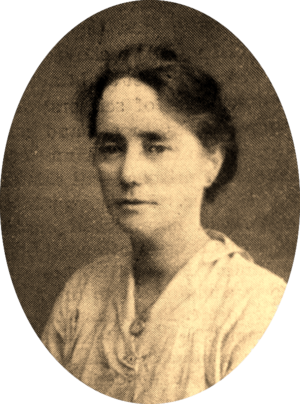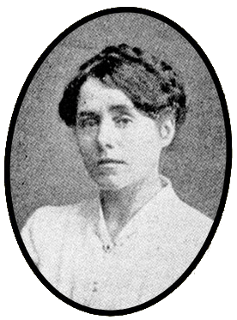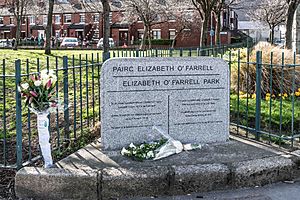Elizabeth O'Farrell facts for kids
Quick facts for kids
Elizabeth O'Farrell
|
|
|---|---|
 |
|
| Born | 5 November 1883 Dublin, Ireland
|
| Died | 25 June 1957 (aged 73) Bray, Ireland
|
| Nationality | Irish |
| Occupation | Midwife, nurse |
| Known for | The delivery of the surrender of the rebels during the Easter Rising |
Elizabeth O'Farrell (Irish: Éilís Ní Fhearghail; 5 November 1883 – 25 June 1957) was an Irish nurse. She was also a republican, meaning she supported Ireland becoming an independent country. She was a member of a group called Cumann na mBan. Elizabeth is most famous for helping to deliver the surrender during the Easter Rising in 1916.
Contents
Early Life and Training
Elizabeth O'Farrell was born in City Quay Dublin on November 5, 1883. Her father, Christopher O'Farrell, worked as a printer. Her mother, Margaret Kenneah, was a housekeeper. Elizabeth was educated by the Sisters of Mercy. When her father died young, she started working at Armstrong's printers. Her mother also ran a small shop.
Elizabeth was part of the Gaelic League, where she learned to speak Irish fluently. In 1906, she joined Inghinidhe na hÉireann, a women's nationalist organization. She became good friends with Julia Grenan there. In 1914, she joined Cumann na mBan, which was the women's branch of the Irish Volunteers. After the 1916 Easter Rising, she became a midwife and worked at the National Maternity Hospital Holles Street.
Elizabeth O'Farrell and the Easter Rising
O'Farrell played an important role before and during the Easter Rising in 1916. She worked as a dispatcher, carrying messages. On Easter Monday, she delivered a message to Athenry. When she returned, she reported to the GPO (General Post Office) in Dublin with her friend, Julia Grenan.
During the Rising, Dublin was a dangerous place with lots of gunfire. Elizabeth and Julia bravely moved through the streets. They carried messages, food, and ammunition. They hid these supplies in their long skirts. They delivered items to different rebel locations, like Boland's Mill and Jacob's Factory. They also helped care for wounded people, including James Connolly, a leader of the Rising.
On Friday of Easter Week, women and wounded people were told to leave the GPO. But O'Farrell, Grenan, and Winifred Carney chose to stay. They moved with the remaining rebel fighters to a house on Moore Street.
Delivering the Surrender
On Saturday, Patrick Pearse, a leader of the Rising, chose Elizabeth O'Farrell for a very important task. He asked her to deliver the surrender terms to the British Army. At 12:45 PM, she was given a Red Cross sign and a white flag. She walked out onto Moore Street, where there was heavy gunfire. The shooting stopped when her white flag was seen.
She was taken to Brigadier General William Lowe. General Lowe sent her back to Pearse with a demand for the rebels to surrender without any conditions. Pearse agreed. He then went with O'Farrell to surrender in person to General Lowe.
A famous photograph shows Pearse facing General Lowe on Moore Street. Just before the picture was taken, O'Farrell stepped back. In the original photo, her feet can be seen next to Pearse. This photo was printed in the Daily Sketch newspaper ten days later. In later copies, her feet were removed from the picture. Some people today say she was "airbrushed from history" because of this. However, O'Farrell's role in the surrender was written about in many books throughout the 20th century.
After the Rising
After the surrender, Elizabeth O'Farrell had another important job. She went with a priest and three soldiers to deliver the surrender order. This order was signed by Pearse. She took it to the rebel units at the Four Courts, the College of Surgeons, Boland's Mill, and Jacob's factory. General Lowe had promised her she would not be held as a prisoner after she delivered these orders.
However, O'Farrell was taken to the Dublin Castle hospital. There, her clothes and belongings were taken away. She stayed there for one night. The next day, she was moved to Ship Street barracks. She was told she would be sent to Kilmainham Jail as a prisoner. O'Farrell and other prisoners were taken to Richmond Barracks. There, she saw Father Columbus, who had been with her at the Four Courts. He promised to tell General Lowe about her situation.
Elizabeth was sent to Kilmainham Jail. But she was later released. General Lowe sent a car to take O'Farrell to Dublin Castle to meet him. He apologized for her being held as a prisoner. He also gave her a letter to show if she had any more trouble with the military.
Life After the Rising
Elizabeth O'Farrell spent the rest of her life working as a midwife and nurse. She worked at the National Maternity Hospital, Dublin. Later, the Irish Government started collecting stories from people who were part of the Irish Revolutionary period. This was for the Bureau of Military History. O'Farrell refused to share her story. She said, "All governments since 1921 have betrayed the Republic." This showed her strong belief in an independent Irish Republic.
In the 1950s, she gave speeches to support the republican movement. She also helped raise money for republican prisoners.
Elizabeth O'Farrell died on June 25, 1957. She was on holiday in Bray, County Wicklow. She is buried in Glasnevin Cemetery in Dublin. She rests in the republican plot, next to her lifelong friend, Julia Grenan.
Commemorations
After Elizabeth O'Farrell's death, the Nurse Elizabeth O'Farrell Foundation was started in 1967. This foundation helps support nurses who want to study further. A special plaque was also put up at Holles Street Hospital. This is where she trained as a midwife from 1920 to 1921. Every year, the hospital gives an award called the 'Elizabeth O'Farrell' commemorative award. It is a silver medal given to a student midwife who does very well in their final exams.
In 2003, another plaque was put up in City Quay park to remember her. O'Farrell was born very close to this area. In 2012, City Quay park was renamed. It is now known as the Elizabeth O'Farrell Park on Sir John Rogersons Quay, Dublin.
In 2016, RTÉ (Ireland's national broadcaster) showed a TV series about the Rising. This was for its 100-year anniversary. The series was called Réabhlóid (meaning Revolution). It had four episodes. The last episode honored Nurse O'Farrell. Episode 4, called 'Famous and Invisible', told the story of O'Farrell's role in the surrender. It also looked at how she was supposedly removed from the original surrender photograph. The episode highlighted lesser-known people from 1916, including Elizabeth O'Farrell.



